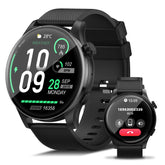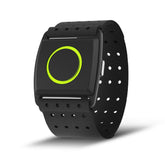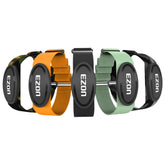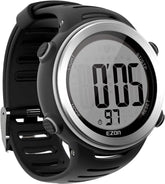Revolutionize Your Running: Heart Rate - Guided Workouts for Peak Performance
Running is more than lacing up and hitting the pavement—it’s a science of energy, endurance, and precision. By training within optimal heart rate zones using a heart rate monitor, you’ll transform generic runs into targeted workouts that boost fat-burning, speed, and stamina. This guide reveals how to decode your body’s signals, tailor workouts to your goals, and run stronger than ever.
1. The Science of Heart Rate Zones: Your Blueprint for Success
A. Calculate Your Max Heart Rate (MHR)
- Formula: MHR = 220 – age (e.g., 40-year-old = 180 BPM).
-
5 Key Heart Rate Zones (as % of MHR):
- Zone 1 (50–60%): Very light (walking, recovery runs)
- Zone 2 (60–70%): Light (fat-burning, aerobic base building)
- Zone 3 (70–80%): Moderate (tempo runs, lactate threshold training)
- Zone 4 (80–90%): Hard (interval training, speed development)
- Zone 5 (90–100%): Very hard (sprint workouts, VO2 max training)
B. Why Zones Matter
- Fat-Burning Efficiency: Zone 2 burns the highest percentage of fat as fuel.
- Speed Development: Zone 4–5 improves anaerobic capacity, critical for 5K sprints or marathon surges.
2. Targeted Workouts for Every Goal
A. Goal: Fat-Burning & Weight Loss
Primary Zone: Zone 2 (60–70% MHR)
-
Workout Example:
- 45–60-minute steady run at a conversational pace (you can speak in full sentences).
- Add 10-minute post-run core work to boost afterburn effect.
- Heart Rate Monitor Tip: Use real-time alerts to ensure you don’t creep into Zone 3, which burns more carbs than fat.
Weekly Plan:
- 3x Zone 2 runs (40–60 mins)
- 1x Zone 1 recovery walk (30 mins)
- 2x strength sessions (squats, lunges)
B. Goal: Speed Training & Race Prep
Primary Zones: Zone 3–4 (70–90% MHR)
-
Tempo Runs (Zone 3):
- 20–30 minutes at 75% MHR (e.g., 10K race pace minus 15 seconds per km).
- Improves lactate threshold, letting you hold faster paces longer.
-
Interval Training (Zone 4):
- 8x400m at 85% MHR with 90-second jog recovery.
- Boosts leg turnover and oxygen uptake for sprint finishes.
Weekly Plan:
- 1x tempo run (Zone 3, 30–40 mins)
- 1x interval session (Zone 4, 20–30 mins)
- 2x easy runs (Zone 2, 40 mins)
C. Goal: Endurance & Marathon Prep
Primary Zone: Zone 2 (60–70% MHR) + Zone 3 (70–80% MHR)
-
Long Runs (Zone 2):
- 1.5–3 hours at easy pace to build glycogen stores and mental stamina.
-
Progression Runs:
- Start at Zone 2, gradually increase to Zone 3 over 60 minutes to simulate race fatigue.
Heart Rate Monitor Insight:
- Track average heart rate during long runs—consistently high HR may mean you’re running too fast for your fitness level.
3. How to Use a Heart Rate Monitor Effectively
A. Real-Time Training Adjustments
- Pace Alerts: Set your watch to vibrate if you’re running too fast for your target zone (e.g., Zone 2 run creeping into Zone 3).
- Effort Calibration: Use the “talk test” alongside heart rate—Zone 2 should feel comfortable, not strained.
B. Recovery Tracking
-
Resting Heart Rate (RHR):
- Measure first thing in the morning; a 5 BPM increase signals fatigue—take a rest day.
-
Heart Rate Variability (HRV):
- High HRV = ready for intensity; low HRV = prioritize yoga or walking.
C. Post-Workout Analysis
- Training Load: Most watches calculate weekly stress scores—aim for 10–15% increases to avoid burnout.
- Calorie Burn Accuracy: Sync with MyFitnessPal to ensure you’re refueling appropriately (e.g., 1,000 calories burned = 30g protein post-run).
4. Common Mistakes to Avoid
-
Overtraining in Higher Zones:
- Solution: Keep 80% of runs in Zone 1–2 to build a strong aerobic base before adding intensity.
-
Ignoring Recovery Zones:
- Solution: Schedule 1–2 days/week of Zone 1 activity (walking, stretching) to promote blood flow and muscle repair.
-
Relying Solely on Perceived Effort:
- Solution: Use a heart rate monitor to eliminate guesswork—especially crucial for beginners.
5. Gear Guide: Choose the Right Heart Rate Monitor
A. Key Features to Prioritize
| Feature | Benefit for Runners | EZON Recommendation |
|---|---|---|
| Wrist-Based Accuracy | No chest strap needed; ideal for daily runs | EZON Heart Rate Series |
| GPS Integration | Track pace, distance, and heart rate together | EZON GPS Series |
| Recovery Metrics | HRV and RHR analysis for smart rest days | EZON Pro Sports Watch |
B. Chest Strap vs. Wrist-Based
- Chest Straps: Most accurate for high-intensity intervals (e.g., Polar H10).
- Wrist-Based: Convenient for easy runs and all-day wear (e.g., EZON HR Watch with 24/7 tracking).
6. Sample 4-Week Training Plan (Fat-Burning Focus)
| Week | Key Workouts | Heart Rate Focus | Recovery Tip |
|---|---|---|---|
| 1 | 3x Zone 2 runs (40 mins) | 60–65% MHR | 1x yoga session for HRV boost |
| 2 | 3x Zone 2 runs (50 mins) + 1x core | 65–70% MHR | Track RHR daily; rest if +5 BPM |
| 3 | 3x Zone 2 runs (60 mins) + 1x hill walk | 60–70% MHR | Sleep 7–9 hours for glycogen repair |
| 4 | 3x Zone 2 runs (45 mins) + 1x stretch | 60–65% MHR | Review weekly calorie burn trends |
7. FAQs: Your Heart Rate Running Questions Answered
Q: Can I train in Zone 5 for fat loss?
- No—Zone 5 burns mostly carbs and is hard to sustain. Stick to Zone 2 for efficient fat oxidation.
Q: How often should I recalculate my MHR?
- Annually or after significant fitness changes (e.g., losing 10kg, training consistently for 6+ months).
Q: What if my heart rate is higher than calculated MHR during sprints?
- Some individuals exceed calculated MHR—trust your watch’s real-time data over formulas for Zone 5 efforts.
Run Smarter, Not Harder
With a heart rate monitor as your coach, every run becomes a step toward precision. Whether you’re torching fat in Zone 2, sharpening speed in Zone 4, or building endurance in Zone 3, let heart rate zones be your guide. Say goodbye to generic workouts and hello to a running routine tailored to your body’s unique needs.
Gear up, set your zones, and let data transform your performance. The road ahead is not just about covering miles—it’s about mastering them. Run with purpose, recover with intention, and let your heart rate be the rhythm that leads you to new PRs and endless progress.
EZON Watch: Professional sports technology brand
https://ezonwatch.com
https://ezonwatch.com









